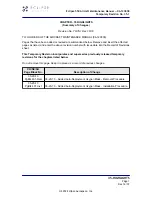
PILOT’S OPERATING HANDBOOK
SECTION 2
LIMITATIONS
EASA Approved
Edition 0 -- October 31, 2013
Rev. 1
Page 2.6.5
ICING CONDITIONS
In any case of icing conditions, first refer to particular procedures described in Chapter 4.5 (normal procedures)
and in case of unforeseen icing conditions, refer in addition to the emergency procedure described in Chapter 3.13.
SEVERE ICING CONDITIONS
WARNING
SEVERE ICING MAY RESULT FROM ENVIRONMENTAL CONDITIONS OUTSIDE OF THOSE
FOR WHICH THE AIRPLANE IS CERTIFICATED. FLIGHT IN FREEZING RAIN, FREEZING
DRIZZLE, OR MIXED ICING CONDITIONS (SUPERCOOLED LIQUID WATER AND ICE
CRYSTALS) MAY RESULT IN ICE BUILD-UP ON PROTECTED SURFACES EXCEEDING THE
CAPABILITY OF THE ICE PROTECTION SYSTEM, OR MAY RESULT IN ICE FORMING AFT
OF THE PROTECTED SURFACES. THIS ICE MAY NOT BE SHED USING THE ICE
PROTECTION SYSTEMS, AND MAY SERIOUSLY DEGRADE THE PERFORMANCE AND
CONTROLLABILITY OF THE AIRPLANE
During flight, severe icing conditions that exceed those for which the airplane is certificated shall be determined by
the following visual cues. If one or more of these visual cues exists, immediately request priority handling from Air
Traffic Control to facilitate a route or an altitude change to exit the icing conditions.
-
Unusually extensive ice accumulation on the airframe and windshield in areas not normally observed to
collect ice.
-
Accumulation of ice on the upper surface of the wing aft of the protected area.
Since the autopilot, when operating, may mask tactile cues that indicate adverse changes in handling
characteristics, use of the autopilot is prohibited when any of the visual cues specified above exist, or when
unusual lateral trim requirements or autopilot trim warnings are encountered while the airplane is in icing
conditions.
Refer to the list of ”Equipment required depending on type of operation” in this same chapter.
Refer to particular procedures described in Chapter 4.5 (normal procedures) and in case of unforeseen icing
conditions, refer in addition to the emergency procedure described in Chapter 3.13.
FLAP OPERATING ENVELOPE
The use of flaps is not authorized above 15 000 ft.
REVERSE UTILIZATION
The use of control reverse BETA (
β
) range is prohibited :
-
during flight,
-
on ground, if the engine is not running.
Содержание TBM 900
Страница 349: ...PILOT S OPERATING HANDBOOK SECTION 7 DESCRIPTION Edition 0 October 31 2013 Rev 1 Page 7 2 7 Figure 7 2 2 2 2 WING FLAPS ...
Страница 385: ...PILOT S OPERATING HANDBOOK SECTION 7 DESCRIPTION Edition 0 October 31 2013 Rev 1 Page 7 4 3 Figure 7 4 1 2 2 ROLL ...
Страница 390: ...PILOT S OPERATING HANDBOOK SECTION 7 DESCRIPTION Edition 0 October 31 2013 Rev 1 Page 7 4 8 Figure 7 4 3 2 2 ELEVATOR ...
Страница 395: ...PILOT S OPERATING HANDBOOK SECTION 7 DESCRIPTION Edition 0 October 31 2013 Rev 1 Page 7 4 13 Figure 7 4 5 2 2 RUDDER ...
Страница 398: ...PILOT S OPERATING HANDBOOK SECTION 7 DESCRIPTION Edition 0 October 31 2013 Rev 1 Page 7 4 16 INTENTIONALLY LEFT BLANK ...
Страница 410: ...PILOT S OPERATING HANDBOOK SECTION 7 DESCRIPTION Edition 0 October 31 2013 Rev 1 Page 7 5 12 Figure 7 5 6 PARKING BRAKE ...
Страница 413: ...PILOT S OPERATING HANDBOOK SECTION 7 DESCRIPTION Edition 0 October 31 2013 Rev 1 Page 7 6 3 Figure 7 6 1 2 2 POWERPLANT ...














































